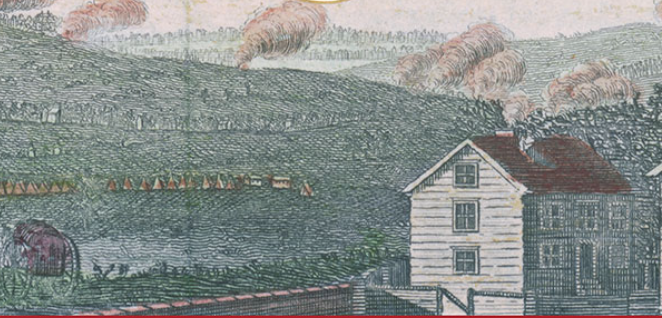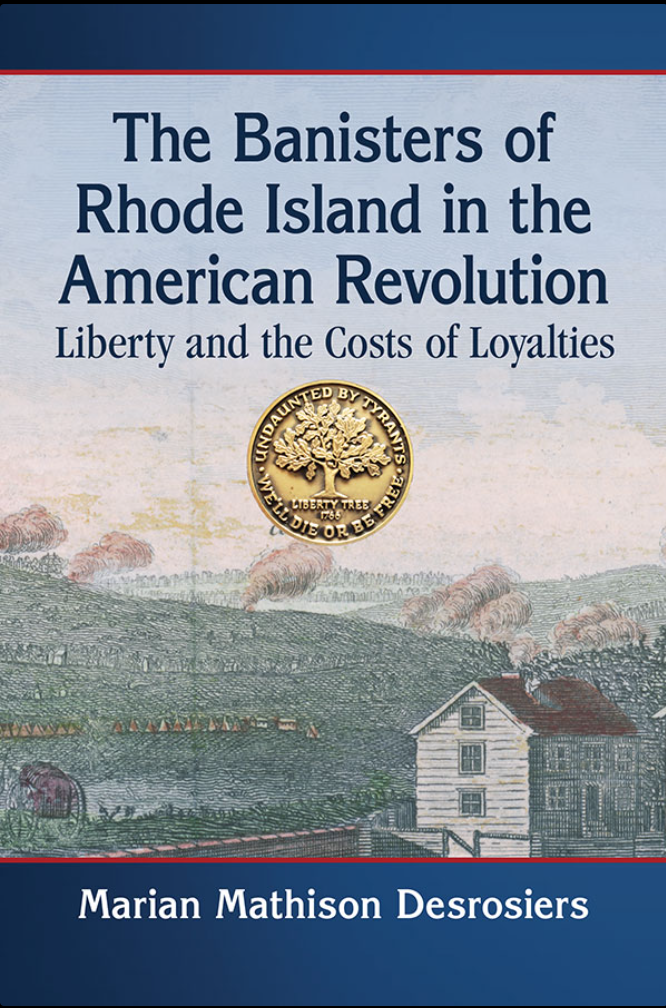Marian Mathison Desrosiers, The Banisters of Rhode Island in the American Revolution: Liberty and the Costs of Loyalties (Jefferson, NC: McFarland, 2021).
In 2017, Marian Mathison Desrosiers, formerly a professor of history at Salve Regina University in Newport, authored a book on John Banister (1707-1767), a successful Newport merchant and shipbuilder from Newport. Using Banister’s numerous account books she revealed a myriad of details on the lives of colonial Newport merchants, laborers, and consumers in the Atlantic trade.
In her latest book, Dr. Desrosiers tells the narrative of the merchant’s two sons, John and Thomas Banister, and their wives, Christian Stelle and Rachel Martin, respectively, and the impact of the American Revolution on their lives. Their stories emphasize the importance of decision-making in a time of disruption and upheaval in two formerly well-established and comfortable colonial families.
The American Revolution in Rhode Island (and in other states) was in part a civil war between Patriots—those who supported independence from Great Britain and Loyalists (also called Tories) who wanted to remain under Crown rule. The Loyalist families in many cases were descendants of men and women who provided leadership in their colonies dating from the seventeenth century. After the Revolution began, those on the Patriot side silenced their fellow Americans, who disagreed with the path of revolt and laws calling for banishment, imprisonment, and confiscations.
When the American Revolutionary War broke out in 1775, Thomas Banister took a somewhat traditional route for young Loyalist men, enlisting in a Loyalist military unit. Thomas joined Wentworth’s Volunteers in 1777 mustering on Long Island. He spent two years protecting Loyalist families from the vagaries and attacks of Connecticut “whale boat men” who pillaged and kidnapped. When the British military garrison in Newport faced a dearth of fighters in 1778, Thomas joined other Associated Loyalist Refugees to fight the Americans invasion of Aquidneck Island to take back the state. In 1779, Thomas joined with other Loyalist forces, raiding “rebel” strongholds in southern New England, including along Narragansett Bay, New Bedford, and Cape Cod.
In late October 1779, the British evacuated Newport, which was a painful experience for Thomas. Rather than stay behind and face the wrath of Patriots, Thomas Banister departed with his unit for British-controlled Long Island. There he was fortunate to meet his future wife, Rachel Martin, from a prosperous Loyalist family.
At war’s end, Thomas found himself on the losing side. He was forced to choose—to stay and be vilified as a Tory and possibly jailed, or to leave America and start a new life somewhere else. Banister chose the latter course, leaving his wife and young sons behind to join thousands of other Loyalists sailing for Nova Scotia in 1783. There Banister tried to develop a farm out of the rugged wilderness. Desrosiers continues by describing the surprising end of Thomas Banister’s story, which I will not give away here. I will say that he and his family were in a somewhat more comfortable situation than his older brother, despite Thomas losing all seven Newport properties and not receiving remuneration from either the British or Rhode Island.
John Banister, Jr.’s story is unusual one, but no less dramatic. Based on his friendship and correspondence with other Loyalists, he seemed to sympathize with the British Crown. But the Reverend Ezra Stiles of Newport’s First Congregational Church did not include him in his well-known list of Newport Tories. With independence declared, Banister was forced to make his choice; he took the oath of allegiance to the United Colonies, although John really wanted to remain neutral. Banister’s main goal was to keep his farms, rental houses and the wharf named after his father (Banister’s Wharf), which were his sources of income and therefore survival.
During the siege of Rhode Island in August 1778, the American army under Major General John Sullivan approached British defensive lines in Middletown, just outside of Newport. In response, the British destroyed one of Banister’s houses and took down hundreds of valuable fruit trees to build batteries and abatis for the line of defense.
Banister decided to travel to London to seek reimbursement for his losses. Despite affidavits of support about British army destruction, he got the run-around from various British authorities. Meanwhile, he stayed in London, using up his financial reserves and relying on Harvard College friends and former Newport neighbors. The main problem for John was that only those who were firm Loyalists and never signed an Oath of Allegiance to Congress were getting reimbursed by the British.
John Banister’s wife, Christian Stelle, remained in Newport, with their son, for four long years. Her task was to avoid the state of Rhode Island from confiscating her house and other Banister properties. Many wives of Loyalist men did the same. Prior to the war, Christian most enjoyed visiting her friends and family in and around Boston; but that ended with the war. Her main duty was to fend off aggressive moves by RI politicians and survive economically.
John rolled the dice by trying to remain neutral—and he lost. Although his petitions for remuneration and restitution did not garner results, John found a path to reintegration in Rhode Island as an American citizen.


























